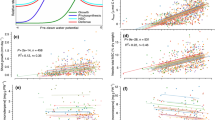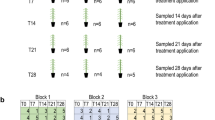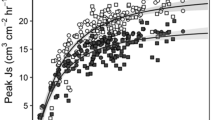Abstract
Key message
The monoterpenoid content of Thuja plicata needles and scales differs both quantitatively and qualitatively. Resin storage structures are associated with anatomical modifications that suggest facilitated exit of monoterpenoids.
Abstract
Western redcedar (Thuja plicata) is a highly valued source of lumber. T. plicata trees planted in reforestations efforts are often heavily damaged by extensive ungulate browsing. Research has shown that high foliar content of monoterpenoids deters browsing, providing an avenue for resistance selection in young plants. T. plicata foliage undergoes, however, extensive phase changes during early growth. Currently it is unknown whether the anatomical basis of monoterpenoid storage and release, and the content and composition of stored monoterpenoids, also change at the same time. Here, we studied these aspects of T. plicata seedling biology. Cotyledons lack storage structures for terpenoids. Needles contain a single longitudinal terpenoid duct with (+)-sabinene and (−)-α-pinene as prevalent monoterpenoids. In contrast, scales contain enclosed resin glands and have a monoterpenoid profile that is markedly different from needles, with α-thujone as the most prevalent monoterpenoid and no detectable levels of (−)-α-pinene. Both ducts and glands are close to the epidermis and vascular tissues, frequently companioned by gaps in the sub-epidermal fiber layer, suggesting paths of facilitated diffusion of monoterpenoids out of tissues. We conclude that foliar phase changes are coupled with equally significant changes in resin storage structure anatomy, monoterpenoid levels and composition. Our findings provide a framework for reproducible sampling and selection not only for high levels of monoterpenoids but also for anatomical markers that may affect release of these compounds.









Similar content being viewed by others
References
Adams RP, von Rudloff E, Hogge L, Zanoni TA (1980) The volatile terpenoids of Juniperus monticola f. monticola, f. compacta, and f. orizabensis. J Nat Prod 43:4–17
Adams RP, Hagerman A (1977) Diurnal Variation in the Volatile Terpenoids of Juniperus scopulorum (Cupressaceae). Am J Bot 64:278–285
Aloni R (2013a) The role of hormones in controlling vascular differentiation. In: Fromm J (ed) Cellular aspects of wood formation. Springer, Berlin, pp 99–139
Aloni R (2013b) Role of hormones in controlling vascular differentiation and the mechanism of lateral root initiation. Planta 238:819–830
Aloni R (2015) Ecological implications of vascular differentiation and plant evolution. Trees 29:1–16
Aloni R, Wolf A, Feigenbaum P, Avni A, Klee HJ (1998) The Never ripe mutant provides evidence that tumor-induced ethylene controls the morphogenesis of Agrobacterium tumefaciens-induced crown galls on tomato stems. Plant Physiol 117:841–849
Aloni R, Foster A, Mattsson J (2013) Transfusion tracheids in the conifer leaves of Thuja plicata (Cupressaceae) are derived from parenchyma and their differentiation is induced by auxin. Am J Bot 100:1949–1956
Biggs AR (1985) Detection of impervious tissue in tree bark with selective histochemistry and fluorescence microscopy. Stain Technol 60:299–304
Bohlmann J, Steele J, Croteau R (1998) Monoterpene synthases from grand fir (Abies grandis). cDNA isolation, characterization, and functional expression of myrcene synthase, (−)-(4S)-limonene synthase, and (−)-(1S, 5S)-pinene synthase. J Biol Chem 272:21784–21792
Burney OT, Davis AS, Jacobs DF (2012) Phenology of foliar and volatile terpenoid production for Thuja plicata families under differential nutrient availability. Environ Exp Bot 77:44–52
Chu FH, Kuo PM, Chen YR, Wang SY (2009) Cloning and characterization of α-pinene synthase from Chamaecyparis formosensis Matsum. Holzforschung 63:69–74
Fahn A, Zamski E (1970) The influence of pressure, wind, wounding and growth substances on the rate of resin duct formation in Pinus halepensis wood. Isr J Bot 19:429–446
Fichan I, Larocche C, Gros JB (1999) Water solubility, vapor pressure, and activity coefficients of terpenes and terpenoids. J Chem Eng Data 44:56–62
Foster AJ, Hall DE, Mortimer L, Abercromby S, Gries R, Gries G, Bohlmann J, Russell J, Mattsson J (2013) Identification of genes in Thuja plicata foliar terpenoid defenses. Plant Physiol 161:1993–2004
Gesell A, Blaukopf M, Madilao L, Yuen MM, Withers SG, Mattsson J, Russell JH, Bohlmann J (2015) The gymnosperm cytochrome P450 CYP750B1 catalyzes stereospecific monoterpene hydroxylation of (+)-sabinene in thujone biosynthesis in western redcedar. Plant Physiol 168:94–106
Goebel K (1913) Organographie der Pflanzen. 1. Teil: Allgemeine Organographie. Jena, Gustav Fischer
Gonzalez JS (2004) Growth properties and uses of western red cedar. Forintek Canada Corp. Special Publication, No. SP-37R
Hudgins JW, Franceschi VR (2004) Methyl jasmonate-induced ethylene production is responsible for phloem defense responses and reprogramming of stem cambial zone for traumatic resin duct formation. Plant Physiol 135:2134–2149
Hudgins JW, Christiansen E, Franceschi VR (2003) Methyl jasmonate induces changes mimicking anatomical defenses in diverse members of the Pinaceae. Tree Physiol 23:361–371
Kaplan DR (1980) Heteroblastic leaf development in Acacia—morphological and morphogenetic implications. Cellule 73:135–203
Kimball BA, Russell JH, Griffin DL, Johnston JJ (2005) Response factor considerations for the quantitative analysis of western redcedar (Thuja plicata) foliar monoterpenes. J Chromatogr Sci 43:253–258
Langenheim JH (1969) Amber: a botanical inquiry. Science 163:1157–1169
Langenheim JH (1990) Plant resins. Am Sci 78:16–24
Langenheim JH (1994) Higher plant terpenoids: a phytocentric overview of their ecological roles. J Chem Ecol 20:1223–1280
Lapasha CA, Wheeler EA (1990) Longitudinal canal lengths and interconnections between longitudinal and radial canals. IAWA Bull 11:227–238
Levinson AS, Lemone G, Smart EC (1971) Volatile oil from foliage of Sequiadendron giganteun: change in composition during growth. Phytochem 10:1087–1094
Lin J, Jack ME, Ceulemans R (2001) Stomatal density and needle anatomy of Scots pine (Pinus sylvestris) are affected by elevated CO2. New Phytol 150:665–674
Martin J, Baltzinger C (2002) Interaction among deer browsing, hunting and tree regeneration. Can J For Res 32:1254–1264
Martin J, Daufresne T (1999) Introduced species and their impacts on the forest ecosystem of Haida Gwaii. In: Wiggins G (ed) Proceedings of the cedar symposium: growing western redcedar and yellow-cypress on the Queen Charlotte Islands/Haida Gwaii. British Columbia South Moresby Forest Replacement Account, BC Ministry of Forests and Ranges, Victoria, pp 69–83
Rosner S, Hannrup B (2004) Resin canal traits relevant for constitutive resistance of Norway spruce against bark beetles: environmental and genetic variability. For Ecol Manag 200:77–87
Russell JH (2008) Deployment of deer resistant western redcedar (Thuja plicata). USDA Forest Service Proceedings. RMRS-P57:149–153
Schmidt A, Nagel R, Krekling T, Christiansen E, Gershenzon J, Krokene P (2011) Induction of isoprenyl diphosphate synthases, plant hormones and defense signalling genes correlates with traumatic resin duct formation in Norway spruce (Picea abies). Plant Mol Biol 77:577–590
Stroh N, Baltzinger C, Martin J (2008) Deer prevent western redcedar (Thuja plicata) regeneration in old-growth forests of Haida Gwaii: is there a potential for recovery? For Ecol Manag 255:3973–3979
Suzuki M (1979) The course of resin canals in the shoots of conifers II. Araucariaceae, Cupressaceae and Taxodiaceae. J Plant Res 92:253–274
Taiz L, Zeiger E (2010) The shoot apex and phase changes. Plant physiology, 5th edn. Sinauer Associates, Sunderland, pp 726–730
Unsicker SB, Kunert G, Gershenzon J (2009) Protective perfumes: the role of vegetative volatiles in plant defense against herbivores. Curr Opin Plant Biol 12:479–485
Vaughn SF, Spenser GF (1993) Volatile monoterpenes as potential parent structures for new herbicides. Weed Sci 41:114–119
Von Rudloff E, Lapp MS, Yeh FC (1988) Chemosystematic study of Thuja plicata: multivariate analysis of leaf oil terpene composition. Biochem Syst Ecol 16:119–125
Vourc’h G, Russell J, Martin J (2002a) Linking deer browsing and terpene production among genetic identities in Chamaecyparis nootkatensis and Thuja plicata. Heredity 93:370–376
Vourc’h G, Garine-Wichatitsky M, Labbé A, Rosolowski D, Martin J, Fritz H (2002b) Monoterpene effect on feeding choice by deer. J Chem Ecol 28:2411–2427
Vourc’h G, Vila B, Gillon D, Escarré J, Guibal F, Fritz H, Clausen TP, Martin J (2002c) Disentangling the causes of damage variation by deer browsing on long-lived tree saplings: a chemical and dendrochronological approach. Oikos 98:271–283
Weidenhamer JD, Macias FA, Fischer NH, Williamson GB (1993) Just how insoluble are monoterpenes? J Chem Ecol 19:1799–1807
Werker E, Fahn A (1969) Resin ducts of Pinus halepensis Mill.—their structure, development and pattern of arrangement. Bot J Lin Soc 62:379–411
White EE, Nilsson JE (1984) Genetic variation in resin canal frequency and relationship to terpene production in foliage of Pinus contorta. Silvae Genet 22:79–84
Wynnchuk A (1994) Evaluation of xylene substitute for paraffin tissue processing. J Histotechnol 17:143–149
Yamamoto F, Kozlowski TT (1987) Effect of ethrel on growth and stem anatomy of Pinus halelensis seedlings. IAWA Bull New Ser 8:11–19
Zotz G, Wilhelm K, Becker A (2011) Heteroblasty—a review. Bot Rev 77:109–144
Acknowledgments
We thank Dr. John Russell for introducing us to the “problem” of resin production in T. plicata foliage and anonymous reviewers for constructive comments on the manuscript.
Author information
Authors and Affiliations
Corresponding author
Ethics declarations
Conflict of interest
The authors declare that they have no conflict of interest.
Additional information
Communicated by A. Gessler.
Electronic supplementary material
Below is the link to the electronic supplementary material.
Rights and permissions
About this article
Cite this article
Foster, A.J., Aloni, R., Fidanza, M. et al. Foliar phase changes are coupled with changes in storage and biochemistry of monoterpenoids in western redcedar (Thuja plicata). Trees 30, 1361–1375 (2016). https://doi.org/10.1007/s00468-016-1373-x
Received:
Accepted:
Published:
Issue Date:
DOI: https://doi.org/10.1007/s00468-016-1373-x




